So, I had planned to tell you all about my Christmas, and my trip to Berlin... but a few things happened to get in the way. On the way home from the Berlin area, I started to have some very bad abdominal pain. It initially felt like heartburn, but it never went away. That was Friday the 7th. Saturday, I didn't feel any better, and some things felt worse. I barely ate dinner that night, and wound up being in excruciating pain Saturday night and Sunday. Monday morning I went into the clinic, and the Dr. immediately noticed something I had missed - I was turning yellow. He sent me to Heidelberg for some blood tests, and an ultrasound. Before Monday was half over, I was admitted to the Hospital in Heidelberg, and undergoing treatment for Gall Stones - I had a complete common bile duct obstruction, giving me difficulty with digestion and essentially blocking my liver and pancreas. During the day on Tuesday, I apparently passed the stone. Wednesday I had a procedure at the Landstuhl Regional Medical Center where they put a tube down my throat and opened the bile duct. I was supposed to have a Laproscopic Coleysystectormy (gall bladder removal) on Thursday the 13th. At the last minute they realized that my Latex allergy meant they couldn't do it in Heidelberg, and I would have to go to Landstuhl for it. I was released for the 4-day weekend, and told I would have the surgery on Tuesday morning. Tuesday came, and they had to bump me to Friday. So, last Friday, I had the surgery. I got back to my quarters on Friday evening. Several days on, I'm still trying to recover from the surgery, but the Gall Bladder (which had more stones in it) is gone, and I can already feel the improvement from having it removed. So, my apologies on the lateness of getting to what happened a month ago, but I've been otherwise occupied for a few weeks.
 Fr. Gianni with the Accolytes on Christmas Eve
Fr. Gianni with the Accolytes on Christmas Eve
So, Christmas was a wonderful service, following my 24 hour shift. Christmas day, my parent's and I went to a wonderful restaurant near where we used to live. In the week following Christmas, we did more travels here and there and everywhere in between - seeing people who could remember me, but I could not remember, or could barely remember. Unfortunately, at this point, it all has become a blur. One day we went back to Rothenburg ob der Tauber - to get some nice pictures in the snow. My last visit had been my first weekend with my new camera - but it was well worth the trip back. We went on to Bamberg to visit old friends there that evening. Another evening, we went to the Roman town of Ladenburg (the one that dates to 120BC), and had a fantastic dinner in a historic restaurant in downtown.
 Rothenburg o.d.T, famous angle
Rothenburg o.d.T, famous angle
New Year's eve, we drove out to a quaint little town on the west side of the valley here, before going to a party with friends in Oftersheim that evening. It was a nice little celebration, but we didn't watch the traditional German "Dinner for One" that evening, nor did we watch the ball drop on Time Square (something to do with the ball drop being at 6am our time). We toasted the new year with Champaign, and fireworks. There were some really intense fireworks that evening - it almost felt like a war-zone. I really feel for all the GIs who had just returned from Iraq earlier that day. I made a few phone calls from 2005 to 2004, but only reached a couple of people (That was always a gimmick we did in my family growing up - calling between time zones over New Year's). On the first day of the year, we drove to another of our old residences, in Stuttgart. Some of the changes were surprising. Our old apartment building is in the midst of renovation, and our old church is no longer a church, but a secure conference room :-(.
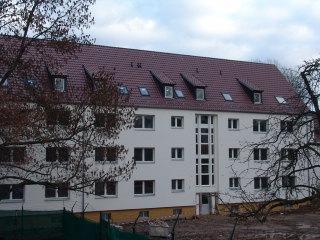 The apartment building we lived in from 1983-1986
The apartment building we lived in from 1983-1986
The 2nd I attended a farewell for our chaplain, who has moved to Monterey California, and the Defence Language Institute - where he will be an instructor in one of his several languages. The farewell was in a Chinese restaurant just south of Heidelberg. It was wild to watch Fr. Gianni speaking Italian with his fiance, German with some of the guests, English with us, and Chinese with the staff. He was able to switch languages effortlessly.
 Fr. Gianni receives his farewell gifts
Fr. Gianni receives his farewell gifts
January 3rd, Monday, I signed out on leave, and we headed up the Autobahn to Berlin, retracing the steps of our trip there in 1987 - when the wall was still up.
Back in the days of the Cold War, the only way we as Americans could travel to West Berlin was either by Air (in designated air corridors, with some white-knuckle moments on approach), by Rail (on a designated non-stop route from the border checkpoint), or by Autobahn - along one corridor. In 1987, we drove up to Helmstead, and processed through Allied Checkpoint Alpha. From there, after several hours, we were able to drive a few hundred meters to the East German Border Control point. Barbed-wire fence, watchtowers, and armed guards were clearly evident. Hours after arriving at the control point, we were then released to drive in a convoy of a few American vehicles overland to the Allied Checkpoint Bravo in West Berlin. The Autobahn was a 4 lane divided highway, in poor repair. The countryside was dreary and bland. Every so often another watch tower was visible. East German Secret Police either watched or followed us for the whole route. On final approach to Checkpoint Bravo, a Soviet Tank was set up on a pedestal as if threatening to charge into West Berlin.
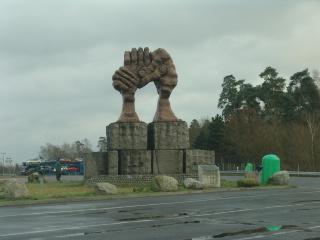 A monument to the "Workers Paradise" where Checkpoint Alpha used to be.
A monument to the "Workers Paradise" where Checkpoint Alpha used to be.
This time, we stopped at the old Checkpoint Alpha - almost unrecognizable - it's a building that has been converted to other uses. The old East German Control Point is still there, but it exists as a memorial to the Iron Curtain. We stopped at it as well. We could have just breezed right through on the 6 lane super-autobahn that runs all the way to Berlin. Here and there along the side of the Autobahn were Media Markt's, Ikea's, McDonald's, Burger King's, etc. None of the old Watchtowers were left. The East German side of Checkpoint Bravo has been replaced by a commercial development site, complete with the Berlin Offices for E-BAY and the like. The tank is gone, but the pedestal is still there, with a piece of worn out construction equipment on top.
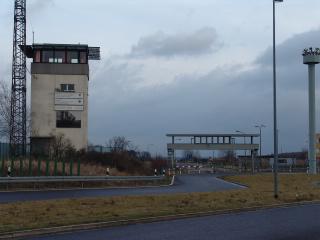 East German Guard Towers on their side of Checkpoint Alpha
East German Guard Towers on their side of Checkpoint Alpha
We spent an hour or two getting completely lost trying to find the family we were going to stay with that evening, finding multiple "you can't get there from here" situations. We did eventually get there. We had a pleasant evening with a Traditional German Brotzeit - Bread and cold-cuts for supper.

From 1961 to 1989, the Berlin Wall encircled West Berlin. It literally cut the city in two, cutting across famous plazas, streets, and buildings. In 1987, we walked along parts of the (western face of) the wall. Famous symbols of the city, such as the Brandenburger Tor (Brandenburg Gate) were on the East side of the wall. One of the most famous sites along the wall was Checkpoint Charlie. U.S. Checkpoint Charlie was the only way we could cross into the Soviet sector of Berlin.
For those of you who don't know, Berlin was divided into sectors for all 4 of the occupying powers following World War II. West Berlin was a conglomeration of the American, French, and British sectors, and East Berlin was the Soviet Sector. In the late 1940s, the Soviets tried to force the capitulation of West Berlin by cutting off all overland access, leaving only air freight for supply. The brand newly created U.S. Air Force began the historic Berlin Airlift, each day bringing in tons of supplies to the besieged city. Eventually, overland access was restored, and the airlift drew to a close. By the late 1950s, the rush of people out of East Germany and East Berlin into the West was heavy. The Soviets took drastic measures, building the Berlin Wall in 1961. From then on, the Berlin Wall, and Checkpoint Charlie, became the very symbols of the Cold War. Today, they are just another name and place for students to forget about in History class, along side the War of 1812, and the Gettysburg address.
Potsdamer Platz, c. 1930:
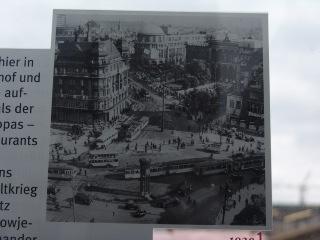
Potsdamer Platz, c. 1961:
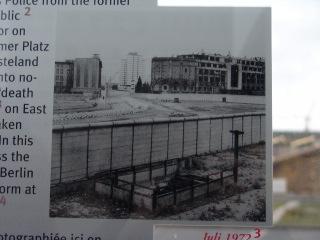
this is roughly how I saw it in 1987.
The morning of the 4th, we took the S-bahn to Potsdamer Platz - once the busiest square in Europe. In 1987, it was a desolate corner of Berlin, with the wall splitting it in two, quite unremarkable. We came up the steps from the underground station, and I was unable to figure out where I was. We stood in the shadow of a fairly decent sky-scraper (about 30 floors). All around us stood new modern office buildings. About 20 feet from the stairs, I saw it. A lone, grafitti coated segment of the Berlin Wall. To either side of it ran a double-cobble-stone wide strip, indicating where the wall used to run. In one direction, the strip ran into the corner of a new building, and then out across the street in the direction of the Brandenburg Gate. In the other, it cut across the street and into a market and out of view into another building. On the segment of wall, were painted the words "An dieser stelle enstand 1989 die erste lücke in der Berliner mauer" - "On this site in 1989, the first hole in the Berlin Wall was made."
 This was my first view of where the wall ran since 1987
This was my first view of where the wall ran since 1987
 The wall used to cut across this now busy street
The wall used to cut across this now busy street
We proceeded effortlessly across the wall and into East Berlin, past a few Embassies, and to the plaza with the Berliner Dom - the Berlin Cathedral. Following a short noonday service, we continued to the Pergamon Museum - a museum of antiquities. Tremendous relics and reconstructions from ancient Pergamon fill this museum.

After the museum, my father and I walked down Unter den Linden - the main street of East Berlin, leading past the Domplatz, the Russian Embassy, and to the Brandenburg Gate. During the cold war, it was the heart of Communist East Berlin. My mother and our host took the bus, and met us at the end by the Brandenburg Gate. On the walk down, I took a picture of the Russian Embassy. Not that it was that interesting, but simply because I could. In 1987, we went into East Berlin, and took some pictures and videos on Unter den Linden. I can remember clearly my father panning with the camera, and having the East German Secret Police come up and stop him from filming. In 1987, if I had tried to take a picture of the Embassy, I would have been arrested, my camera confiscated, the film destroyed, and I _might_ have eventually been returned to the west. It is also possible I would have been put on trial for being a spy. So, because I could, I did.
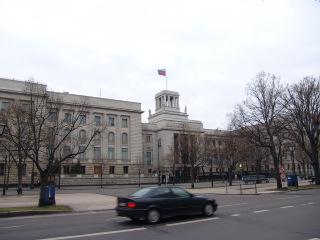
We reached the Brandenburger Tor, and it was impressive to me to be able to walk up to it, and through it. In 1987, it was in the no-man's-land, essentially within the Wall. In 1989, it was on the West side of the wall, looking towards the Tor that 90% of the coverage of the fall of the wall was set, it was in that no-man's-land that the biggest parting occurred on the night of the 9th of November. We crossed through the gate, and into West Berlin, then walked along the old course of the wall to the Reichstag - the German equivalent of the Capital building. Here and there along the way were white crosses for memorials for those who died trying to flee the East. A few pictures around the Reichstag (and of the incredible amount of construction that wasn't there in '87) and we went to have a bit of "Kaffee und Kuchen" - "Coffee and Cake" is a traditional German afternoon "meal" closely related to the English "Tea and Crumpets" - in the shadow of the Brandenburger Tor.
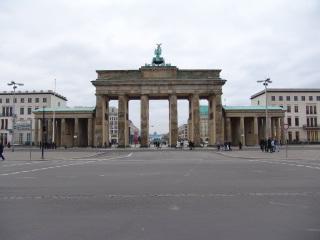
If you look closely, you can see the arc where the wall ran in front of the gate
Afterwards, we took some dusk photos of the now illuminated gate, and then took the U-bahn through some historic (in a spy-vs-spy sense) stations to the Kochstraße U-bahn station - one block south of Checkpoint Charlie, on the West side of the wall. We approached this Historic location after sunset. Years ago, I was told it was unrecognizable anymore - they removed the checkpoint on both sides, and it was just another intersection in Berlin. A few years ago, they restored the U.S. portion of the checkpoint, and in the last year or so, a memorial has been erected on the former East Berlin side. On the actual border, a few feet beyond the checkpoint building, there now stands a large internally light sign. Facing from the West side, it is a Soviet soldier. Facing from the East side, it is a U.S. Solider. To one side stands the famous sign that reads:
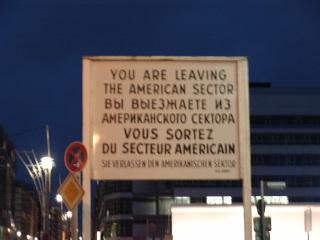
"YOU ARE LEAVING THE AMERICAN SECTOR.
Bbl BblE3mAETE N3 AMEPNKAHCKOrO CEKTOPA.
VOUS SORTEZ DU SECTEUR AMERICAIN.
SIE VERLASSEN DEN AMERIKANISHEN SEKTOR."
Often quoted in T-Shirts and Mugs.
Running down either side away from the street with the checkpoint, on the East Berlin side, is a reconstruction of the wall as it appeared before the fall. Immediately on the other side of the wall, on both sides, countless black crosses stand in white gravel. They are not the organized, dress-right-dress of a military cemetary, but facing in random directions - a stark contrast to the orderly white marble crosses of the American Cemetery in Normandy. On each cross is affixed a laminated card. One such card reads:
"Paul Rebenstock
nach erfolgreichter Flucht in die DDR "zurückgeolt" und hingerichtet oder zu Tode gebracht. + 5. März 1954 im Alter von 48 Jahren
"brought back" to the GDR, executed or killed after a successful escape. + March 5, 1954 at the age of 48 years."
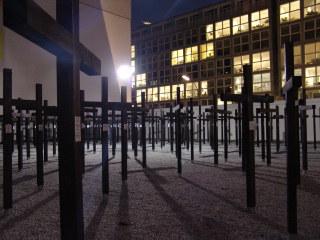
Standing in this place, seeing these crosses, remembering what it was, I was moved to tears. The museums and souvenir shops have pictures of what it looked like at various times in history. Seeing the pictures of the Soviet and American tanks facing off across the checkpoint, seeing the crosses of all those who died seeking freedom, having seen the wall with my own eyes - remembering the fear I had of the Soviet troops and East German guards....
Checkpoint Charlie is a memorial to what we as America did. A plaque explaining the memorial talks about it. "Here is where the people of the United States of America effectively vowed to stand up for basic rights." Those tanks facing of across the checkpoint, as well as the tens of thousands of troops facing off across the inter-German border - the very reason I grew up in Germany - wasn't about power or conquest. It was about a promise. Every day that the wall stood, the U.S. Army sent a Jeep (or Humvee) to tour the Soviet Sector of Berlin. They did the same. The U.S. Army had a brigade stationed in Berlin. In the event of war, the harsh reality was they were expected to be wiped out in the initial assault. We didn't put them there to sacrifice them - we put them there, maintained our presence as a promise. We are here with you. We have not forgotten you. This glittering Island of Liberty deep in then East Germany was something that would not be ignored. It was a reminder to all who saw it what the promise of Liberty was.
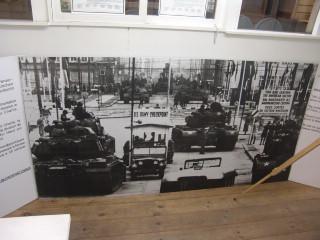 A picture inside the restored Checkpoint Charlie, showing the tanks standing off across the border in the 1960s.
A picture inside the restored Checkpoint Charlie, showing the tanks standing off across the border in the 1960s.
About a block from Checkpoint Charlie, along the wall, there stands a 200m original section of the wall. It is chipped, and battered and worn, as though forced to endure a millennium of weathering. Looking at the chipped, battered, and worn stretch of wall, I could not help but feel the pressure of humanity that willed the wall down. I could feel the rage at decades of imprisonment and division that tore into that wall with bare hands. The blood, sweat, and tears of the entire nation of Germany - East and West - had torn into this wall. The scars of this division are fading. Some will remain forever.

Crossing back across the checkpoint, the other side of the famous sign reads:
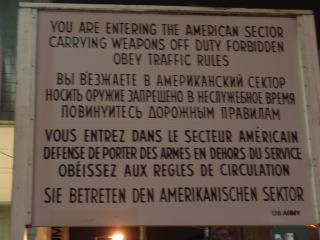
"YOU ARE ENTERING THE AMERICAN SECTOR
CARRYING WEAPONS OFF DUTY FORBITTEN
OBEY TRAFFIC RULES
Bbl BE3mAETE B AMEPNKAHCKNN CEKTOP
HOCNTb OPYmNE 3AnPEWEHO B HECnYmEbHOE BPEMR
nOBNHYNTE Cb ^OPOmHbIM nPABNnAM
VOUS ENTREZ DANS LE SECTEUR AMERICAIN
DEFENSE DE PORTER DES ARMES EN DEHORS DU SERVICE
OBEISSEZ AUX REGLES DE CIRCULATION
SIE BETRETEN DEN AMERIKANISHEN SEKTOR"
Along the sidewalk leading between the checkpoint and the museum, are the words "EINEHEIN IN FREIHEIT - UNITY IN LIBERTY - UNITE EN LIBERTE - ANHCTBO B CBO6OAE"

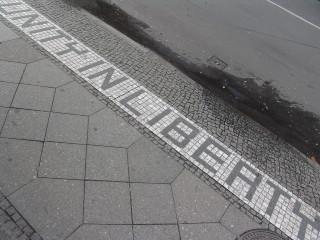

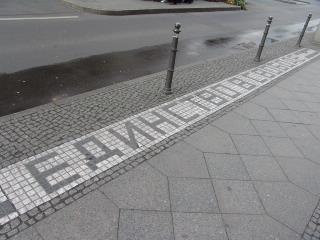
We returned to the U-bahn, and headed for dinner. It was another pleasant evening of a traditional german brotzeit, sharing some wine and other goodies. I was introduced to a SMOOOOOTH spanish Coniac - "CARLOS III". Note, if you EVER get a chance to try some, do so. I have never found any that even gets close to it in quality.
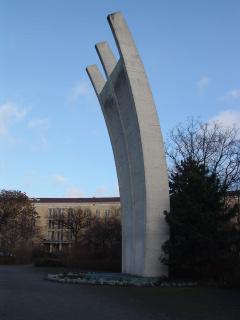
Berlin Airlfit Memeorial
The next morning, we visited the Berlin end of the Berlin Airlift Monument (the other end is at the Rhine-Main Air Force Base in Frankfurt, about an hour north of where I live in Mannheim), followed by a daytime visit to Checkpoint Charlie. We then drove off through East Berlin and on north towards the Polish Baltic city of Stettin. Unfortunately, the policy on our rental prohibited us from driving it into Poland, so we had to park and cross the border by foot. We stopped just short of the border control point, and rather than take pictures at the control point, we went to the Grenzstein - border stone - about 100m south of the control point. We weren't trying to sneak across the border, and we actually followed an existing trail - we were hardly the first to do this. I finally got to beat my parents into a country - by about 2m and one minute. We took some pictures of each other as we crossed, and on both sides - then the border patrol showed up.
 I got there first!
I got there first!
We were detained by the Polish border patrol (we were on the German side when they stopped us - and could not cross the border to detain us), and we had to wait for about an hour while they got German and Polish control people to come check our passports. They did a call up to their HQ with our information, and determined that we were not international drug smugglers, and let us go.
 But I was not alone.
But I was not alone.
We spent the next two nights in the small Brandenburg town of Tarmow, outside Fehrbellin north of Berlin. We were hosted by a local family my father had met through business dealings 10 years ago. They were not transplanted from West Germany, this family was a (reasonably) typically family from the former East Germany. It was a striking contrast to what we have come to accept as normal in the rest of Germany. There is very little illumination at night. The more economically viable towns and businesses look fairly modern and well kept - but some are just as run down as the whole countryside was 15 years ago. They have internal plumbing, but only have hot water for the shower/tub. Heating in the whole region tends to be by coal. They live comfortably enough, but the standard of living is 25 years or more behind West Germany, and even farther behind the U.S.
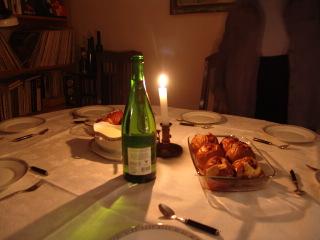 A simple baked apple nachtisch
A simple baked apple nachtisch
Friday, we had yet another traditional German breakfast - with some very greasy salami. We hit a grocery store before we left town, while we were inside, I started developing some heartburn. Before we hit the checkout I was in severe pain. I was in prolonged severe pain for the return trip, and unfortunately do not remember much of it clearly. By Sunday I was starting to become jaundiced, and Monday I was checked into the hospital. My parents stayed with me in the hospital for that afternoon/evening, and we made arrangements to get them to the airport on Tuesday without me. Their return flight was safe.
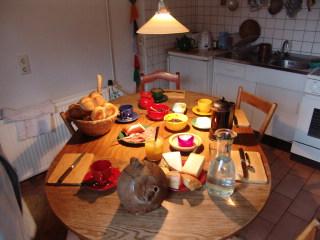 I didn't know when I took this picture what it would come to represent for me...
I didn't know when I took this picture what it would come to represent for me...
Today, my color has cleaned out, my incisions are itching, and the medications are making me high... but I'm healing. I got to be home for the 4-day weekend, but I didn't do anything but rest. I'm on leave now, but I'm not allowed to drive for almost two more weeks.
I'm not sure when I'll be going anywhere again, and I'm not sure where I might go. I'll be playing a great deal of that by ear. I'm seriously looking at doing Scotland and Ireland this summer - I have a friend from church who has retired to Dundee Scotland. I need to find my way to Prague CZ, and Budapest H, and a trip up to see the Fjords of Norway and Sweden. I also have to go to Rome. If I can, I want to hit more, but I'm rapidly going to run out of time and $ to do such things before this year is out.
So, that's my fun and excitement for the last month or so...hopefully I can have some more of the good adventures, and a little less of the time in the Hospital in the next one.
Charles.
p.s. I decided against posting my immediate post-surgical picture showing the dressings and such. Best to leave some things to imagination, or forget all together.
 Fr. Gianni with the Accolytes on Christmas Eve
Fr. Gianni with the Accolytes on Christmas Eve Rothenburg o.d.T, famous angle
Rothenburg o.d.T, famous angle The apartment building we lived in from 1983-1986
The apartment building we lived in from 1983-1986 Fr. Gianni receives his farewell gifts
Fr. Gianni receives his farewell gifts A monument to the "Workers Paradise" where Checkpoint Alpha used to be.
A monument to the "Workers Paradise" where Checkpoint Alpha used to be. East German Guard Towers on their side of Checkpoint Alpha
East German Guard Towers on their side of Checkpoint Alpha


 This was my first view of where the wall ran since 1987
This was my first view of where the wall ran since 1987 The wall used to cut across this now busy street
The wall used to cut across this now busy street




 A picture inside the restored Checkpoint Charlie, showing the tanks standing off across the border in the 1960s.
A picture inside the restored Checkpoint Charlie, showing the tanks standing off across the border in the 1960s.






 I got there first!
I got there first! But I was not alone.
But I was not alone. A simple baked apple nachtisch
A simple baked apple nachtisch I didn't know when I took this picture what it would come to represent for me...
I didn't know when I took this picture what it would come to represent for me...